

| Note: Move cursor over product name to display. Click for larger size and info | ||||||||||||||||||||||||||||||||||||||||||||||||||||||||||||||||
|
||||||||||||||||||||||||||||||||||||||||||||||||||||||||||||||||
|
||||||||||||||||||||||||||||||||||||||||||||||||||||||||||||||||
| Note: Move cursor over product name to display. Click for larger size and info | ||||||||||||||||||||||||||||||||||||
|
||||||||||||||||||||||||||||||||||||
|
||||||||||||||||||||||||||||||||||||
| 850-hPa Zonal Wind | 200-hPa Zonal Wind | 200-hPa Vel Potential | 850-hPa Vel Potential |


MJO composites using the Wheeler and Hendon (2004) MJO index. The index is based on a combined Empirical Orthogonal Function (EOF) analysis using outgoing longwave radiation, 850 hPa zonal wind and 200 hPa zonal wind as input. ENSO and other low-frequency variability is removed in order to target the MJO signal. Shading on the following plots indicate significance at the 95% confidence interval. Contours for all areas are shown for reference.
| November - March | May - September | |
|---|---|---|
| 200 hPa Velocity Potential | 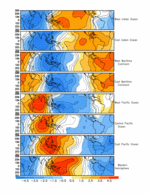 | 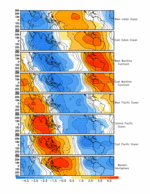 |
| Outgoing Longwave Radiation | 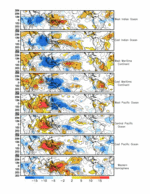 | 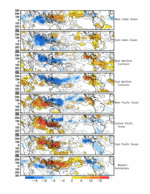 |
| Precipitation | 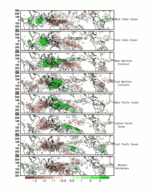 | 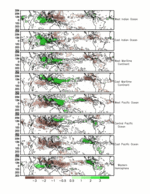 |
| 850 hPa Wind and Velocity Potential | 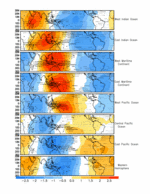 | 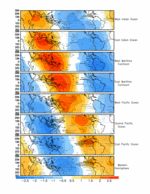 |
| Sea Level Pressure | 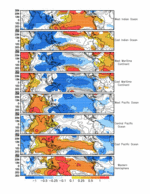 | 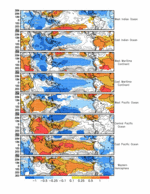 |
|
Higgins, R. W., and S. D. Schubert, 1996: Simulations of persistent North Pacific circulation anomalies and interhemispheric teleconnections. J. Atmos. Sci., 53, 188-207. Higgins, R. W., and K. C. Mo, 1997: Persistent North Pacific circulation anomalies and the tropical intraseasonal oscillation. J. Climate, 10, 223-244. Higgins, R. W., J. K. Schemm, W. Shi and A. Leetmaa, 2000a: Extreme precipitation events in the western United States related to tropical forcing. J. Climate, 13,793-820. Higgins, R. W., and W. Shi, 2001: Intercomparison of the principal modes of interannual and intraseasonal variability of the North American Monsoon System. J. Climate, 14, 403-417. L'Heureux, M. L. and R. W. Higgins, 2008: Boreal Winter Links between the Madden-Julian Oscillation and the Arctic Oscillation. J. Climate, In press. Kousky, V. and M. Kayano, 1994: Principal modes of outgoing longwave radiation and 250-mb circulation for the South American sector. J. Climate, 1994, 1131-1143. Kayano, M. and V. Kousky, 1999: Intraseasonal (30-60 day) variability in the global tropics: principal modes and their evolution. Tellus, 51, 373-386. Mo, K. C. and R. W. Higgins, 1998: Tropical influences on California precipitation. J. Climate, 11, 412-430. Zhang, C. and J. Gottschalck, 2002: SST Anomalies of ENSO and the Madden-Julian Oscillation in the Equatorial Pacific. Journal of Climate, 15, 2429-2445. |